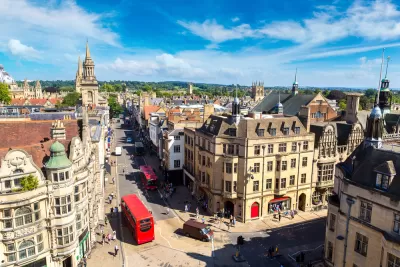Proposals for road diets, ‘15-minute cities,’ and other traffic reduction programs often meet with unfounded conspiracy theories claiming that the plans are nothing short of steps to world domination.

Pointing to an example from Oxford, England, The Guardian’s Peter Walker explores why conspiracy theorists are drawn to traffic calming plans, claiming there are more sinister reasons behind them.
According to the theories, promoted by far-right Canadian psychologist Jordan Peterson, among others, “Oxford’s traffic plan, they insist, is the first step in a global plot led by – depending on who you listen to – the World Economic Forum (WEF) or the UN, designed to strip people of their fundamental rights and personal possessions in the name of the environment.” Walker first debunks the claims. “It is worth stressing that no trip will be impossible, though some could be longer than before, with drivers instead having to use a less central route such as the city’s ring road.”
According to Walker, conspiracies connected to cars and traffic abound in part because “efforts to limit people’s right to drive, whether in previous years through residents’ parking zones, or more recently with low-traffic neighbourhoods, have often prompted a furious response, usually from a noisy minority.” These fears tie in with “climate conspirators,” who believe climate change is an elaborate scheme to bring the world under the control of an international cabal.
Why should we care about a small group of people believing absurd claims? “One significant worry is that people objecting to traffic restrictions can easily become exposed to much murkier ideas,” Walker explains.
FULL STORY: Why do traffic reduction schemes attract so many conspiracy theories?

Study: Maui’s Plan to Convert Vacation Rentals to Long-Term Housing Could Cause Nearly $1 Billion Economic Loss
The plan would reduce visitor accommodation by 25,% resulting in 1,900 jobs lost.

North Texas Transit Leaders Tout Benefits of TOD for Growing Region
At a summit focused on transit-oriented development, policymakers discussed how North Texas’ expanded light rail system can serve as a tool for economic growth.

Why Should We Subsidize Public Transportation?
Many public transit agencies face financial stress due to rising costs, declining fare revenue, and declining subsidies. Transit advocates must provide a strong business case for increasing public transit funding.

How to Make US Trains Faster
Changes to boarding platforms and a switch to electric trains could improve U.S. passenger rail service without the added cost of high-speed rail.

Columbia’s Revitalized ‘Loop’ Is a Hub for Local Entrepreneurs
A focus on small businesses is helping a commercial corridor in Columbia, Missouri thrive.

Invasive Insect Threatens Minnesota’s Ash Forests
The Emerald Ash Borer is a rapidly spreading invasive pest threatening Minnesota’s ash trees, and homeowners are encouraged to plant diverse replacement species, avoid moving ash firewood, and monitor for signs of infestation.
Urban Design for Planners 1: Software Tools
This six-course series explores essential urban design concepts using open source software and equips planners with the tools they need to participate fully in the urban design process.
Planning for Universal Design
Learn the tools for implementing Universal Design in planning regulations.
City of Santa Clarita
Ascent Environmental
Institute for Housing and Urban Development Studies (IHS)
City of Grandview
Harvard GSD Executive Education
Toledo-Lucas County Plan Commissions
Salt Lake City
NYU Wagner Graduate School of Public Service





























